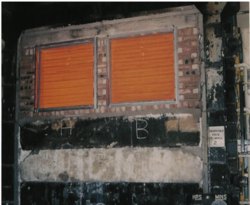New standards for fire protection in ductwork

tTesting rotating-blade fire dampers to the new European standard involves enclosing them in a plenum to check that their leakage does not exceed 200 m3/h per square metre of cross-sectional area at a differential pressure of 300 Pa.
Terry Farthing is concerned that although new standards for preventing the spread of smoke and flame through ductwork are imminent, the use of traditional curtain fire damper will still be permitted in some areas.In the constantly changing alphabet soup of the Building Regulations, an important development relating to fire safety in ductwork systems is approaching. Those in the building-services industry will be familiar with the changes to Part L (conservation of fuel and power) and Part F (ventilation) — but how many know that major changes to Part B are due in April 2007? Part B covers all fire precautionary measures that are necessary to provide safety from fire that will safeguard building occupants, persons in the vicinity of buildings, and fire fighters. Of particular interest to Terry Farthing, sales director with Trox UK, whose expertise includes ventilation, is the integration into Part B of new European fire standards relating to fire protection in ducted ventilation and air-conditioning systems. He says, ‘When this happens, it will totally change the UK fire-damper market — potentially making the popular curtain fire damper redundant.’ Curtain fire dampers as traditionally used in the UK consist of a series of blades that are retained at one side of a rectangular section of ductwork — until they are released. The blades then form an interlocking barrier to inhibit the passage of smoke and flame. In contrast, the new Part B will generally require the use of fire-damper modules with a pivoted blade of insulated material. In the event of fire, or for testing, this blade rotates to close off the ductwork. Terry Farthing believes that traditional curtain fire dampers present a number of safety issues. • They are prone to jamming, so they may not close when required. • The fan has to be shut off so as not to comprise their effectiveness. • It is not possible to operate them with an electrical actuator, so testing is difficult. Curtain fire dampers are often inaccessible, so that it is difficult to reset them after operation — which Terry Farthing suggests leads to testing being neglected. Finally, such dampers are tested against a positive pressure on their hot side of a maximum of 20 Pa — and pass if the gaps that open up are not larger than 6 mm. He tells us that the new approach is based on European practice, so that such issues do not arise. Not only can the damper, in both circular and rectangular ductwork, be shut against fan pressure, but that fan pressure can actually help the damper rotate to its closed position. The pivoted blade can readily be closed by direct-coupled rotary actuators, and, indeed, there are a number on the market specifically designed for fire applications. Not only can single-blade fire dampers be readily tested, but the procedure can be automated. The chasm between shutter and single-blade fire dampers suddenly widens dramatically when the test criteria are considered. Basically the leakage past a rotating blade is required to be almost negligible. The figure is 200 m3/h per square metre of internal cross-sectional area at a pressure difference across the damper of 300 Pa. That is a leakage of little more than 50 l/s for a duct with an area of a square metre. Although the traditional curtain fire damper will still be permitted in some applications in the UK, Terry Farthing believes this is an unacceptable compromise. He points out that in buildings where people sleep (such as hospitals and hotels) only single-blade dampers will be permitted. The same applies in the core area of a high-rise office block, although the traditional curtain damper will be permitted elsewhere. That continuing use of curtain dampers bothers Terry Farthing, who sees it as compromising safety and an issue that might also be a cause of concern to insurance companies. While a rotating-blade damper is rather more expensive than a curtain damper — about double — he believes that the extra cost makes so little impact on the overall cost of a project that curtain fire dampers should be consigned to history.
Related links:









